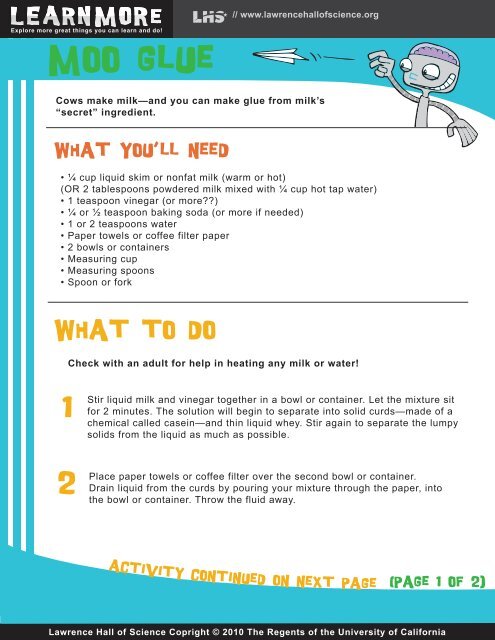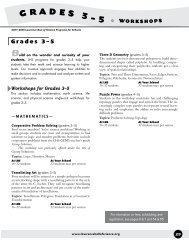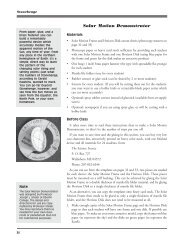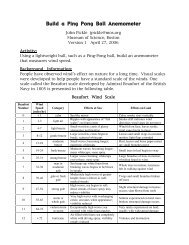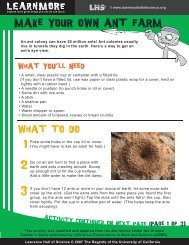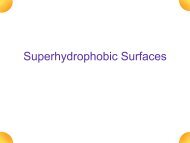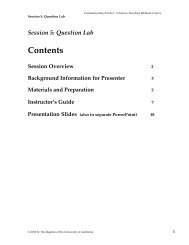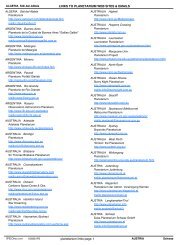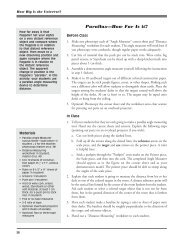Moo Glue - Lawrence Hall of Science
Moo Glue - Lawrence Hall of Science
Moo Glue - Lawrence Hall of Science
You also want an ePaper? Increase the reach of your titles
YUMPU automatically turns print PDFs into web optimized ePapers that Google loves.
Explore more great things you can learn and do!<br />
<strong>Moo</strong> <strong>Glue</strong><br />
WHAT YOU , LL NEED<br />
WHAT TO DO<br />
// www.lawrencehall<strong>of</strong>science.org<br />
Cows make milk—and you can make glue from milk’s<br />
“secret” ingredient.<br />
• ¼ cup liquid skim or nonfat milk (warm or hot)<br />
(OR 2 tablespoons powdered milk mixed with ¼ cup hot tap water)<br />
• 1 teaspoon vinegar (or more??)<br />
• ¼ or ½ teaspoon baking soda (or more if needed)<br />
• 1 or 2 teaspoons water<br />
• Paper towels or c<strong>of</strong>fee filter paper<br />
• 2 bowls or containers<br />
• Measuring cup<br />
• Measuring spoons<br />
• Spoon or fork<br />
1<br />
2<br />
Check with an adult for help in heating any milk or water!<br />
Stir liquid milk and vinegar together in a bowl or container. Let the mixture sit<br />
for 2 minutes. The solution will begin to separate into solid curds—made <strong>of</strong> a<br />
chemical called casein—and thin liquid whey. Stir again to separate the lumpy<br />
solids from the liquid as much as possible.<br />
Place paper towels or c<strong>of</strong>fee filter over the second bowl or container.<br />
Drain liquid from the curds by pouring your mixture through the paper, into<br />
the bowl or container. Throw the fluid away.<br />
activity continued on next page<br />
(page 1 <strong>of</strong> 2)<br />
<strong>Lawrence</strong> <strong>Hall</strong> <strong>of</strong> <strong>Science</strong> Copright © 2010 The Regents <strong>of</strong> the University <strong>of</strong> California
Explore more great things you can learn and do!<br />
// www.lawrencehall<strong>of</strong>science.org<br />
<strong>Moo</strong> <strong>Glue</strong> (activity continued)<br />
3 Put<br />
5 Add<br />
4 Add<br />
6<br />
the curds back into one <strong>of</strong> the bowls or containers. Use a spoon or<br />
fork to break the curds into tiny bits.<br />
baking soda and water to the curds. Stir until smooth to make your<br />
glue mixture.<br />
a little more water or baking soda to the glue to get the thickness you<br />
want.<br />
Refrigerate your glue to make it last longer. (Outside the frig, your glue<br />
will start to smell bad in about a day.)<br />
DID YOU KNOW?<br />
• Sticky iurds are made <strong>of</strong> a chemical called casein, which is <strong>of</strong>ten used in<br />
manufacturing bread.<br />
• Milk glue has been used for hundreds <strong>of</strong> years.<br />
(page 2 <strong>of</strong> 2)<br />
<strong>Lawrence</strong> <strong>Hall</strong> <strong>of</strong> <strong>Science</strong> Copright © 2010 The Regents <strong>of</strong> the University <strong>of</strong> California


